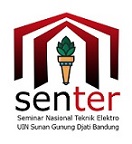Wearable Antenna Jenis Mikrostrip dengan Struktur Electromagnetic Band Gap (EBG) untuk Komunikasi Wireless pada Tubuh
Keywords:
wearable antenna, mikrostrip, electromagnetic band gapAbstract
Wearable antenna jenis mikrostrip merupakan salah satu teknologi komunikasi nirkabel untuk tujuan pemantauan pada manusia yang dapat terintegrasi dengan pakaian serta menjaga kenyamanan pengguna. Akan tetapi, antena mikrostrip memiliki sejumlah kelemahan seperti gain dan efisiensi yang rendah, lebar pita sempit serta adanya gelombang permukaan yang dapat merusak pola radiasi. Selain itu, penggunaan wearable antenna memungkinkan terjadinya efek mutual coupling antara tubuh dengan antena yang dapat mengubah frekuensi kerja, penurunan kinerja antena dan efek radiasi pada tubuh. Berdasarkan permasalahan di atas, diberikan struktur Electromagnetic Band Gap (EBG) dengan unit cell berbentuk Mushroom-like EBG dan via pada bagian tengan EBG. Penggunaan struktur EBG tersebut dapat meningkatkan efisiensi, mengurangi efek mutual coupling, menghasilkan pola radiasi yang lebih baik serta mengurangi efek radiasi pada tubuh. Pengujian dilakukan pada antena tanpa struktur EBG dan dengan struktur EBG pada rentang lebar pita 10-100 MHz untuk frekuensi kerja 3,5 GHz 5G Band (n78 3500 MHz) dan nilai SAR ≤ 1,6 W/Kg. Didapat nilai VSWR <2, return loss ≤-10, lebar pita >30 MHz dan gain >5 dB.
The microstrip wearable antenna is a wireless communication technology for monitoring the human body that can be integrated with clothing and maintain user safety and comfort. However, microstrip antenna have some disadvantages such as low gain and efficiency, narrow bandwidth and surface waves that can destroy the radiation pattern. In addition, the use of a wearable antenna possibly makes a mutual coupling effect between the body and the antenna which can change the resonant frequency, decrease the performance of the antenna and the effect of radiation on the body. Based on these problems, an Electromagnetic Band Gap (EBG) structure was added with a unit cell in the shape of a Mushroom-like EBG and a via in the centre of the EBG the antenna design. The use of the EBG structure can increase efficiency, reduce the effect of mutual coupling, produce a better radiation pattern and reduce the effects of radiation on the body. The study was carried out on antennas without EBG structure and with EBG structure in a bandwidth range of 10-100 MHz for a resonant frequency of 3.5 GHz 5G Band (n78 3500 MHz) and a SAR value less than 1.6 W/Kg. The value of VSWR <2, return loss ≤-10, bandwidth >30 MHz and gain >5 dB.
Downloads
References
N. H. M. Rais, P. J. Soh, F. Malek, S. Ahmad, N. B. M. Hashim, and P. S. Hall, “A review of wearable antenna,” Loughbrgh. Antennas Propag. Conf. LAPC 2009 - Conf. Proc., no. May 2014, pp. 225–228, 2009, doi: 10.1109/LAPC.2009.5352373.
M. I. Zaman, F. T. Hamedani, and H. Amjadi, “A new EBG structure and its application on microstrip patch antenna,” 2012 15th Int. Symp. Antenna Technol. Appl. Electromagn. ANTEM 2012, pp. 2–4, 2012, doi: 10.1109/ANTEM.2012.6262420.
A. Y. I. Ashyap et al., “Highly efficient wearable CPW antenna enabled by EBG-FSS structure for medical body area network applications,” IEEE Access, vol. 6, pp. 77529–77541, 2018, doi: 10.1109/ACCESS.2018.2883379.
G. Mu and P. Ren, “A Compact Dual-Band Metasurface-Based Antenna for Wearable Medical Body-Area Network Devices,” J. Electr. Comput. Eng., vol. 2020, 2020, doi: 10.1155/2020/4967198.
M. S. Alam, N. Misran, B. Yatim, and M. T. Islam, “Development of electromagnetic band gap structures in the perspective of microstrip antenna design,” Int. J. Antennas Propag., vol. 2013, 2013, doi: 10.1155/2013/507158.
R. Salvado, C. Loss, Gon, and P. Pinho, “Textile materials for the design of wearable antennas: A survey,” Sensors (Switzerland), vol. 12, no. 11, pp. 15841–15857, 2012, doi: 10.3390/s121115841.
“What is n78 band of 5G Network?,” Router-switch.com, 2020. .
Z. Guo, H. Tian, X. Wang, Q. Luo, and Y. Ji, “Bandwidth enhancement of monopole uwb antenna with new slots and ebg structures,” IEEE Antennas Wirel. Propag. Lett., vol. 12, pp. 1550–1553, 2013, doi: 10.1109/LAWP.2013.2292063.
C. A. Balanis, Antenna Theory Analysis and Design, Second Edition, John Wiley & Sons, Inc.
O. Ayop, M. K. A. Rahim, and T. Masri, “Dual Band Electromagnetic Band Gap ( EBG ) Structure,” vol. 1, pp. 6–8, 2007.
A. Ahmad, F. Faisal, S. Khan, S. Ullah, and U. Ali, “Performance Analysis of a Wearable and Dual Band Planar Antenna Using a Mushroom-like Electromagentic Bandgap ( EBG ) Ground Plane,” pp. 24–29, 2015.
M. El Atrash, M. A. Abdalla, and H. M. Elhennawy, “A Wearable Dual-Band Low Profile High Gain Low SAR Antenna AMC-Backed for WBAN Applications,” IEEE Trans. Antennas Propag., vol. 67, no. 10, pp. 6378–6388, 2019, doi: 10.1109/TAP.2019.2923058.



